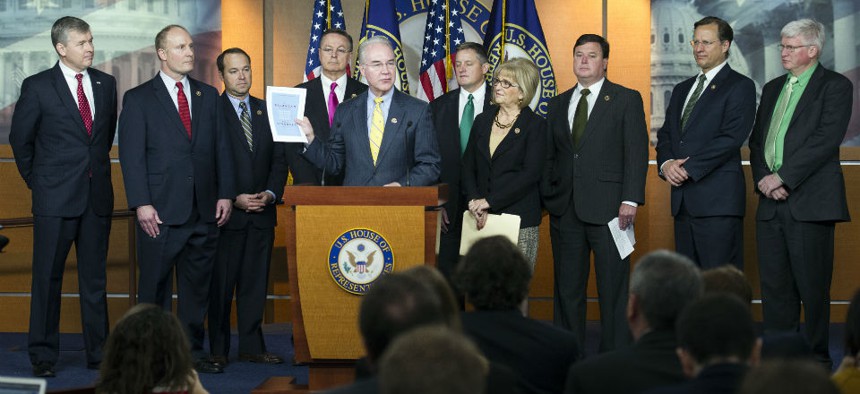GOP Budget: Higher Pension Contributions for Feds, Much Lower Spending for Civilian Agencies
Republicans suggest familiar cuts to federal employees and agencies to achieve $5.5 trillion in savings.
This story has been updated.
House Republicans have once again called on federal employees to contribute more to their retirement, bringing back the effective pay cut in their fiscal 2016 budget blueprint.
Following the precedent set by Rep. Paul Ryan, R-Wis., who no longer sits on the House Budget Committee, new Chairman Rep. Tom Price, R-Ga., included a pension contribution hike for feds as part of the $5.5 trillion in total savings the budget proposed over the next 10 years.
“In keeping with a recommendation from the National Commission on Fiscal Responsibility and Reform, this budget calls for federal employees—including members of Congress and congressional staff—to make greater contributions toward their own retirement,” the legislative text stated.
While the plan did not specify exactly how much pension contributions would increase, the commission on fiscal responsibility – known as the Simpson-Bowles Commission – recommended “gradually” increasing federal civilian pensions “so that new federal employees ultimately pay about one-half the cost of their pensions, and existing federal employees pay one-quarter.”
A Budget Committee spokesman confirmed that the 50-50 split would amount to a 6.35 percent contribution level from feds, the same level Ryan’s budget recommended last year.
Congress has already raised the pension contribution level for newer employees twice in recent years, creating a three-tiered system in which employees pay between 0.8 percent and 4.4 percent of their paychecks toward their defined benefit, depending when they were hired.
More broadly, Price’s budget would officially maintain the across-the-board spending levels mandated by sequestration, but it would still boost Defense spending above the levels in President Obama’s fiscal 2016 budget request, through the use of additional funding in the Overseas Contingency Operations account technically reserved for emergency spending.
The plan did not spell out specific cuts to the federal workforce, but the cuts to non-defense agency budgets would likely result in hiring freezes and job losses. The plan would cut non-Defense funding by $759 billion below sequestration caps by 2025.
Rep. Chris Van Hollen, D-Md., ranking member of the House Budget Committee, said the Republican proposal represented the “same old, same old,” and it was “not a serious budget.”
Van Hollen said the blueprint would “wreak havoc with the services that civil servants provide to Americans across the country.” On the proposed increase to pension contributions, he added, “This is just a huge hit on hardworking federal employees.”
Asked whether the Republican budget moved the needle closer to a sequestration avoiding compromise similar to the one agreed to in 2013 by Ryan and Sen. Patty Murray, D-Wash., the Democrats’ House Budget point man said it was more of a step backward. He went on to lament it was “too early to say” if the framework was a step forward for resuming regular order in the budget and appropriations process, and staving off the specter of a government shutdown in September.
The American Federation of Government Employees slammed the proposal, saying Republicans are “slashing the compensation and jobs of hard-working federal employees.”
“Federal employees aren’t some faceless bureaucrats to be cut at a whim,” said AFGE National President J. David Cox, in a statement. “They are real people with real jobs who make a real difference in the lives of millions Americans every day…They deserve our respect and admiration, not the contempt and derision being presented in this budget.”
The plan did note that the embattled Veterans Affairs Department would receive sufficient funding. Republicans also promised to maintain their tight oversight of the agency.
“We will continue to closely monitor the VA to make sure they are accountable and transparent in their work,” Price wrote.
The resolution identified areas of redundancy and called on agencies to reduce waste and increase accountability. Price added the overall, governmentwide funding cuts were simply a necessary rollback of unfettered growth in recent years.
“These reductions are hardly draconian,” Price said. “Washington cannot keep spending money it does not have.”
To further reduce spending to reach a balanced budget in 10 years, House Republicans also proposed significant cuts to Medicare and Medicaid, creating a premium support system for Medicare and block grants for Medicaid.
The military would not be completely exempt from cuts, either. While overall Defense spending would rise under the Republican plan, the blueprint still proposed reductions to compensation for military personnel and retirees. Price embraced the recommendations made by the Military Compensation and Retirement Modernization Commission earlier this year. The reforms, Price said, are “vital to sustaining the long-term fiscal health” of the military benefits.
“Under current law, if personnel compensation costs continue to grow as expected, they will inevitably crowd out critical defense spending on readiness and procurement,” Price wrote.
Senate Republicans plan to release their own budget Wednesday, and both chambers plan to vote on passage next week. Specific spending levels will then be determined during the annual appropriations process.








